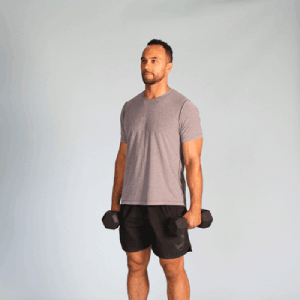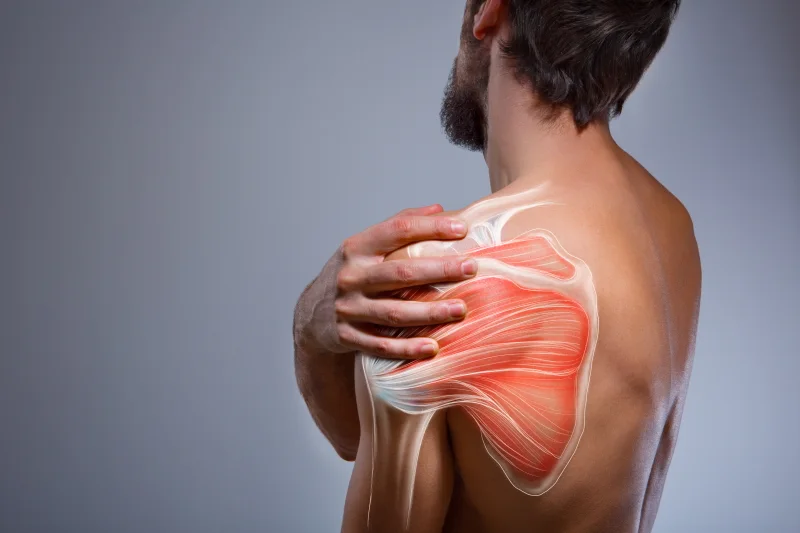The deltoid muscle, a key part of your shoulder, plays a big role in everyday tasks, like lifting things or reaching overhead. It’s always working hard! In this guide, we’re going to explore the world of deltoid pain, check out how to treat it, strategies for recovery, and much more.
But that’s not all – keep reading to discover what you can expect when dealing with deltoid pain and how it’s taken care of. So, let’s dive in and get started!
Contents
What Is Deltoid Muscle and What Does It Do?
 The deltoid muscle is a crucial part of your shoulder, and understanding its role is key to appreciating how it affects your daily movements. Shaped like a triangle, the deltoid muscle covers the rounded top of your shoulder and is made up of three distinct sections.
The deltoid muscle is a crucial part of your shoulder, and understanding its role is key to appreciating how it affects your daily movements. Shaped like a triangle, the deltoid muscle covers the rounded top of your shoulder and is made up of three distinct sections.
These three heads are:
- This front part of the deltoid muscle originates from the clavicle (collarbone) and attaches to the humerus. It is primarily responsible for lifting the arm forward.
- The middle part of the deltoid muscle starts from the acromion (a bony process of the scapula) and also inserts into the humerus. It plays a key role in lifting the arm to the side.
- The rear part of the deltoid muscle originates from the scapular spine and inserts into the humerus. Its primary function is to help raise the arm backward.
Functionally, the deltoid muscle is a powerhouse.
- Lifting and Holding: It’s responsible for lifting your arm away from your body, allowing you to carry objects and keep them in place.
- Reaching High: When you reach overhead to grab something from a high shelf, it’s the deltoid muscle that’s doing the heavy lifting.
- Rotational Movements: Whether you’re waving or throwing a ball, the deltoid muscle is involved in various rotational movements of the arm.
In essence, the deltoid muscle is your shoulder’s MVP, enabling a wide range of movements essential for daily activities. Understanding its anatomy and functions lays the foundation for comprehending the intricacies of deltoid pain and its management.
Signs To Look Out For Deltoid Muscle Pain
 When the deltoid muscle is injured, certain signs may indicate the presence of pain or discomfort. Being aware of these signs is crucial for early recognition and timely intervention. Here’s what to watch for:
When the deltoid muscle is injured, certain signs may indicate the presence of pain or discomfort. Being aware of these signs is crucial for early recognition and timely intervention. Here’s what to watch for:
- Location of Pain: Individuals with deltoid muscle pain may experience discomfort at the front, side, or back of the shoulder.
- Pain During Movement: The pain is often more noticeable when lifting the arm or engaging in activities that involve shoulder movement.
Understanding the severity of deltoid muscle pain involves categorizing it into different grades:
Grade 1: Mild Discomfort
- Symptoms: Tightness in the muscle and minimal swelling.
- Experience: Individuals may feel mild discomfort, but the pain is generally manageable.
- Movement: Range of motion is typically not significantly affected.
2: Moderate Pain
- Symptoms: Increased pain, swelling, and limited movement.
- Experience: Individuals may find the pain more pronounced, accompanied by noticeable swelling.
- Movement: Limited range of motion compared to Grade 1.
Grade 3: Severe Pain
- Symptoms: These serious injuries can cause severe pain, and significant swelling, and may result in a visible muscle bulge or gap.
- Experience: Individuals with Grade 3 deltoid muscle pain may find it challenging to move their shoulder without intense pain.
- Movement: Limited range of motion, and professional medical attention is crucial.
Recognizing the signs and understanding the grading of deltoid muscle pain is vital for appropriate care and recovery. If you suspect deltoid muscle pain, seeking medical advice can help determine the extent of the injury and guide the most effective treatment plan.
Causes Behind The Pain
 Deltoid pain, like an unwelcome guest, often arrives unannounced, leaving us wondering about its origins. Let’s unravel the mystery behind the discomfort and explore the common causes that may be triggering pain in your deltoid muscle.
Deltoid pain, like an unwelcome guest, often arrives unannounced, leaving us wondering about its origins. Let’s unravel the mystery behind the discomfort and explore the common causes that may be triggering pain in your deltoid muscle.
Deltoid pain is often a consequence of pushing your shoulder muscles beyond their limits. Here’s the breakdown:
- Overuse Without Rest: Picture your deltoid muscle as a diligent worker tirelessly lifting and reaching. But just like any hardworking individual, it needs its fair share of rest. Overusing the deltoid muscle without adequate rest or warm-up can pave the way for discomfort, potentially leading to a muscle strain or tear.
- The Strain Chronicles: A strained muscle, affectionately known as a “pulled muscle,” can be the result of overexertion. Imagine your deltoid giving its all during weight lifting, swimming, skiing, or playing baseball without a proper warm-up – that’s a recipe for strain.
Who’s More Likely to Experience Deltoid Pain?
This discomfort is not biased; it can sneak up on anyone, but it might be more inclined to visit those who engage in strenuous exercises involving the shoulder.
So, if you find yourself frequently lifting weights, gliding through the water in a pool, conquering slopes on skis, or swinging for the fences on the baseball diamond, your deltoid muscle might be sending out distress signals.
Understanding the causes behind deltoid pain is the first step in mitigating discomfort and embracing a proactive approach to shoulder health. Remember, giving your deltoid muscle the care it deserves can keep that pain at bay.
Relief From Deltoid Pain: Deltoid Muscle Pain Treatment
Dealing with deltoid pain requires a strategic approach, and the initial steps can make a significant difference. If you find yourself in the grip of deltoid discomfort, here’s your go-to guide for relief:
1. Immediate Action

- Rest: The first order of business is giving your deltoid muscle some well-deserved rest. Avoid activities that strain the shoulder to prevent further damage.
- Ice: Apply an ice pack to the affected area for about 15-20 minutes. This helps reduce swelling and provides immediate relief. If you have a minor injury, 15 minutes on and 15 minutes off a few times throughout the day for 1 to 2 days should be enough. If you have a more serious injury, or if you still have swelling, you can ice for a few more days. Applying ice periodically for 3–5 days can significantly aid in the recovery process.
- Heat: After the initial icing, introducing heat can ease muscle tension. A warm compress or a hot shower can be soothing.
2. Over-the-Counter Relief: Anti-Inflammatories
- Use over-the-counter anti-inflammatories, such as ibuprofen or naproxen, to reduce inflammation, swelling, and discomfort. Always follow the recommended dosage and consult with a healthcare professional if you have any concerns.
Remember: It’s crucial to strike a balance between rest and gentle movement. Gradually reintroduce activities and exercises as your deltoid muscle begins to recover. If the pain persists or worsens, seeking medical advice is advisable for a more comprehensive treatment plan.
Relieving Deltoid Pain: Easy Stretches and Exercises
Getting rid of that annoying deltoid pain doesn’t have to be complicated. Let’s break it down with some simple stretches and exercises that anyone can do:
Deltoid Stretches
Arm Across the Chest
 Stand or sit comfortably. Bring your sore arm across your chest, gently pulling it with the other arm. Hold it there for 30 seconds
Stand or sit comfortably. Bring your sore arm across your chest, gently pulling it with the other arm. Hold it there for 30 seconds
Arms Behind the Back and Clasp the Hands
 Stand up straight. Put your hands behind your back, locking them together. Lift your hands towards the sky, as far as you feel good doing.
Stand up straight. Put your hands behind your back, locking them together. Lift your hands towards the sky, as far as you feel good doing.
Deltoid Exercises
Military Press:

- Stand strong, like a soldier.
- Hold a weight in each hand, lift them up, then bring them back down.
- Do this 10-15 reps, three sets– simple!
Dumbbell Lateral Raise:

- Hold a weight, lift your arm to the side, then lower it.
- Repeat 10-12 times, three sets
Rear Deltoid Row with TRX:

- Grab something stable, lean back a bit, and pull yourself up.
- Do this 10-15 times, three sets
Standing Band Lateral Raises:

- Stand with a band in each hand.
- Lift your arms to the side, then bring them back down.
- Do it ten times, three sets
Incorporating these stretches and exercises into your routine can help alleviate deltoid pain and contribute to overall shoulder health. Remember to perform them with proper form and consult with a healthcare professional if you experience persistent discomfort or have any concerns.
Understanding how long it takes to recover from deltoid pain is essential for planning your healing journey. Here’s a breakdown based on the severity of the injury:
- Minor Strain:
- Recovery Time: 1 to 2 weeks.
- Steps: Begin with rest, ice, and heat – the trio of champions for initial recovery. Continue resting until your pain starts to fade.
- Partial Tearing:
- Recovery Time: 4 to 6 weeks.
- Steps: Embrace the rest-ice-heat routine as your initial savior. Give your shoulder the time it needs to heal.
- Serious Tear:
- Recovery Time: Up to 4 months.
- Steps: The journey is longer, but rest, ice, and heat remain your faithful companions. Healing takes time, so be patient.
Guidelines for Returning to Activity:
- Minor Deltoid Injury:
- Ease back into exercising after a few days.
- You shouldn’t have to stop entirely unless the pain becomes unbearable.
- More Serious Deltoid Injury:
- Stop exercising your arm for at least 1 to 2 weeks.
- Once pain decreases, gradually reintroduce strengthening and stretching exercises.
However, it is crucial that if you start exercising and experience excessive pain, stop and allow more time for rest.
Understanding your recovery timeline and respecting the need for rest and gradual reintroduction of activities is key to a successful healing process. Listen to your body, and don’t rush the journey to full recovery.
Conclusion
Incorporating stretches, exercises, and relief treatments into your routine can be a game-changer when it comes to battling deltoid pain. However, it’s essential to recognize when it’s time to seek professional guidance.
Here’s the deal: If your pain persists and interferes with your daily activities, or if relief measures aren’t bringing the expected comfort, it’s time to consider consulting a doctor or a physiotherapist. Look out for signs like trouble moving or using your arm properly, especially if you notice shoulder swelling or sudden pain during arm movements. These could be indicators that a deeper evaluation is necessary.
If you’re experiencing persistent shoulder pain, consider reaching out to PhysioMantra for online physical therapy for shoulder pain. Our expert therapists can guide you through tailored exercises and treatments to alleviate your discomfort. Book an online physical therapy session today and take the first step towards a pain-free shoulder!



